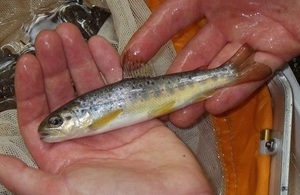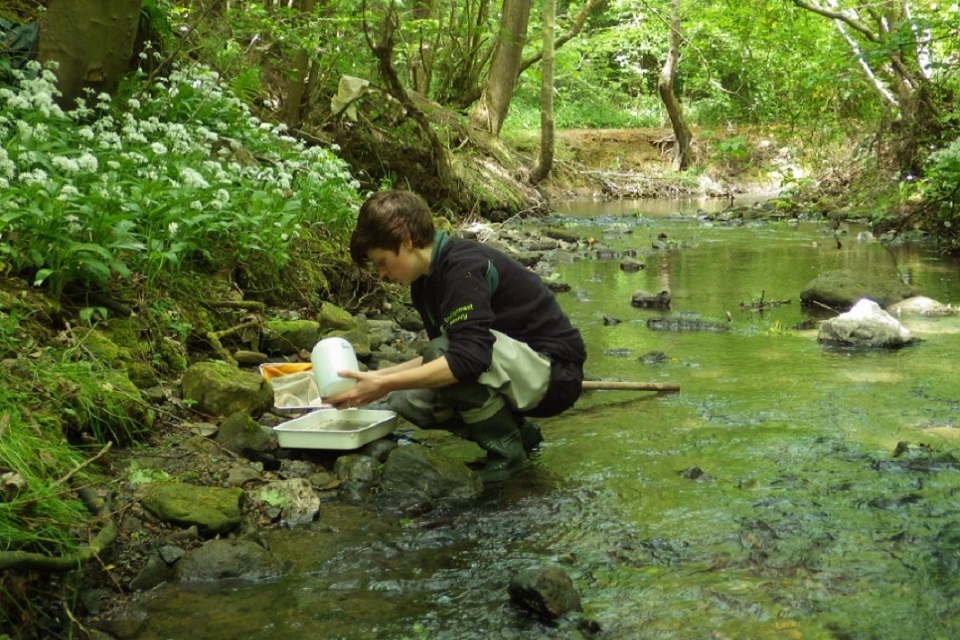Fish find shows mine water scheme is reaping rewards
Environment Agency surveys at Saltburn-by-the-Sea indicate mine water treatment scheme is helping restore a once heavily polluted Gill.

Image shows a trout found at Saltburn Gill in recent surveys
There’s early indications that a mine water treatment scheme is reaping rewards after lots of fish were found in a once heavily polluted bright orange watercourse in Saltburn-by-the-Sea.
During recent Environment Agency monitoring surveys at Saltburn Gill the water was running clear and fish stocks – including juvenile brown trout, bullheads and a juvenile flounder - were spotted.
The encouraging signs come just months after the new Saltburn mine water treatment scheme was officially opened on 1 July.
The £3.6million scheme was funded by the Department for Environment, Food and Rural Affairs (Defra) and was carefully designed by Coal Authority experts, in partnership with the Environment Agency and Defra, to address pollution problems caused by historic mining operations. It started operating during 2015.
‘Fantastic to see fish returning’
Environment Minister Thérèse Coffey said:
The water in Saltburn Gill is now running clear and it is fantastic to see fish like the brown trout and European bullhead returning to these rivers.
I am delighted Defra funded this scheme which has made a huge difference to the natural environment, so future generations are able to enjoy these waters once more for years to come.

Image shows the Environment Agency's Jess Anson carrying out a survey at Saltburn Gill
The Environment Agency’s Richard Jenkins, Team Leader of the North East Analysis and Reporting Team which carried out the surveys, said:
Our rivers are the healthiest they’ve been for 20 years and schemes like this are playing an important role in ensuring water quality improvements continue.
Certainly the results of this survey is excellent news and an early indication that the great partnership work to improve the gill is making a difference for this generation and generations to come.
There appears to be a positive biological response to the work, but there’s still a lot of investigation to do. The monitoring is part of a much wider project looking into the restoration of the watercourse.
We’re carrying out a number of ecological and water quality investigations over the coming months and years to monitor any improvements.
Delighted with excellent performance
Tracey Davies, Head of the Environment Team at the Coal Authority, added:
We are delighted with the excellent performance of the system, as it removes in excess of 98% of iron from the raw mine water before the cleaned water is released into the local waterways.
This means we are preventing over 100 tonnes of iron from entering the Saltburn Gill and the North Sea every year.
It is schemes like this that will help us create even more effective and sustainable mine water treatment sites elsewhere in Britain and we have estimated that stopping this iron entering the water at Saltburn-by-the-Sea has the potential to add £10.5million into the local economy over the next 25 years.
The area of East Cleveland saw large scale deep mining for well over 100 years. When local ironstone mining operations stopped in the 1960s, the pumps that removed water from the mines were turned off and removed.
Water made its way into the old mine workings and eventually reached the surface in 1999. Although not harmful to people, the iron ochre caused severe pollution to both the Skelton Beck and Saltburn Gill, discoloured the beach and sometimes caused an orange plume to form in the North Sea.
A community group – Saltburn Gill Action Group – worked with the Environment Agency and Coal Authority to gain funding to investigate options to clean up the pollution and together they secured the necessary funds from the Department of Environment, Food and Rural Affairs to address the issue for the community.